When we moved into our newly-acquired House At The Lake (official name still under discussion) we were initially pleased that it featured a Sub-Zero refrigerator in the kitchen. My spouse liked the way it looked, and I’m a sucker for clever engineering. Let me esplain.
Most residential reefers share a single compressor and thermostat for refrigeration and freezing purposes. A single thermostat controls the temperature in the freezer, and a moveable flap determines how much of the cold air leaks into the refrigerator section. The “freezer” knob controls the thermostat, and the “refrigerator” knob moves the flap. There is obviously unpredictable thermal interaction between the two, which sometimes leads to confusion and mis-diagnoses, but the design is cost-efficient, and works well enough for the vast majority of refrigerator-equipped homes in the world.
Sub-Zeros, which are built into the overall kitchen cabinet decor, utilize a two-compressor design, one compressor and thermostat for the freezer section, and a separate compressor and thermostat for the refrigerator section. In addition, they are tightly sealed, making them highly efficient. I don’t know that I would have ever chosen to purchase one by itself, but between the built-in look and the quality reputation, I can see why a family building a nice, new kitchen might opt for one.
After a fairly short time, however, we discovered that there were a few “areas for improvement” with our refrigerator.
Opening it
The ability to open one’s refrigerator is not an outlandish expectation. However, at least for ours, that was initially a challenge. The combination of the tight seal, and the cabinet-like design, meant that, for normal mortals, eight fingers on both hands were required.
I personally could open it with one hand, but I am a near-professional bass player, and you should not try this at home.I spent a few days mentally exploring options. First, I made sure that there were no magic tricks, hidden levers, or tapped holes indicating a missing handle. The user’s manual gave no hints. I contemplated the construction of a handle, first from aluminum, next from ultra-high-molecular-weight polyethylene (one of my favorite problem-solvers from my Superior Steel Fabricators days), but decided that whatever I built might tear the door molding off, or spoil the seal. And it would most likely, despite my best efforts, be ugly. I have seen some of my work.
So I finally turned to my narrow, yet shallow, nautical lore, and decided to try a rope. Yep. Sounds horrid, doesn’t it. But at least I got a white rope, to match the decor. Initially I used nylon, because I actually had some white nylon rope of the right diameter. Nylon rope is nice on the hands, but it eventually stretches and requires re-tightening. So after a few months, I bought some white polypropylene, and it has served us well. The way the door molding is designed, the rope fits right into the groove, and, if tied correctly, stays in place.
A friend of the previous owners (Ed and Wendy) visited our house not long after I installed the rope. Obviously very familiar with the problem, he laughed out loud when saw my solution, and insisted on sending Ed a photo.
So now we can get into the refrigerator with just one hand. Then we discovered one or two additional problems. Maybe three.
Chill, dude
There was a definite temperature differential between the lower shelves and the upper shelves of the refrigerator. Not only did a thermometer show it, you could tell when you picked up a quart of milk, or drank a bottle of whatever.
Symptom two was the fact that items in the lowest drawers froze solid, which is not the recommended state for lettuce. If we raised the temperature setting enough to prevent freezing, objects on the top shelf began to come back to life. Not a recommended state for food.
Finally, over the first few months of using the refrigerator, but unbeknownst to us, an iceberg gradually formed behind the drawers on the bottom shelf, to the point that the shelves wouldn’t close, which is when we finally noticed it. It took about twenty minutes with a hair dryer to loosen the ‘berg into big chunks I could remove. After another few months, it happened again. Another iceberg, another twenty minutes. Ed admitted they had suffered from the same problem.
At this point I was tempted to just replace the refrigerator. But it fit so snugly into the kitchen cabinetry. And they ain’t givin’ ’em away, either. Back to the drawing, er, thinking, board.
As far as I could tell, the refrigerator was working as designed. The water for the iceberg could only have been condensation, since the freezer and ice maker were below the refrigerator, and it was too much to attribute to spillage.
I looked at some service call notes in the stack of house information and manuals Ed had left (thank you, Ed), and at multiple variations of Sub-Zero circuit diagrams (thank you, Internet).
I finally concluded that the problem was the clever design. There is a small circulating fan under the cooling coils at the top of the refrigerator section, which runs when the compressor is on. Unfortunately, due to the efficient seal and separate compressor design, the compressor just doesn’t run very much. Which means the less-cool air in the refrigerator rises to the top, while the thermostat sensor chilling out at the bottom of the compartment still thinks all is well. And water that condenses on the sides, runs down to eventually form an iceberg on, and around, the drip lip on the back panel.
Clearly some circulation was needed. I mused about various solutions, including a wind-up fan, or a battery-operated fan. But eventually I came back to the Sub-Zero circuit diagrams. Some of the later diagrams show the little fan at the top running all the time, not just when the compressor runs.
I estimated the additional cost of electricity due to increased fan operation, and added in a possible replacement cost for the fan down the road. The answer was still less than the value of the milk we would throw out in a year. Not to mention the cost of running a hair dryer for twenty minutes every few months, with the refrigerator door wide open.
So after a jury-rigged test run, I re-wired the harness near the door switch with a “y-assembly” of 16-gauge wire and crimp-on connectors.
The result
So far, so good. The top-shelf stuff feels cooler, lasts longer, and the thermometer shows the temperature in the correct range most of the time.
We can still open the door, and nobody makes fun of the rope, especially if I threaten to remove it.
And there is no hint of an iceberg forming yet.
If I had no shame, I might call it a Titanic achievement. Which, apparently, I don’t.
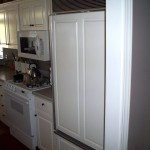
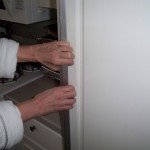
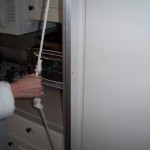


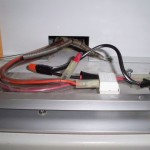
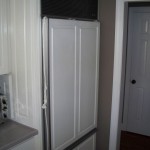
I really like both of these solutions, actually. The rope is so appropriate for a lake house, too.
I can’t figure out where the wiring patch is located though. Is it on top of the fridge?
Comment by marilyn — February 9, 2012 @ 2:04 pm
In the middle, at the top of the refrigerator door, barely visible in a couple of overall photos, are the two switches shown on the diagram as light switch and fan switch. They are accessible by removing the grille, which also covers the two compressor units. The close-up shows the tops of the two switches.
Comment by etblog — February 10, 2012 @ 12:21 pm
I just saw this post. I have no words. Made me laugh….. If you were on American Idol, they would say “You are in it to win it, Dawg…”
Comment by Cathy — March 16, 2012 @ 10:27 am